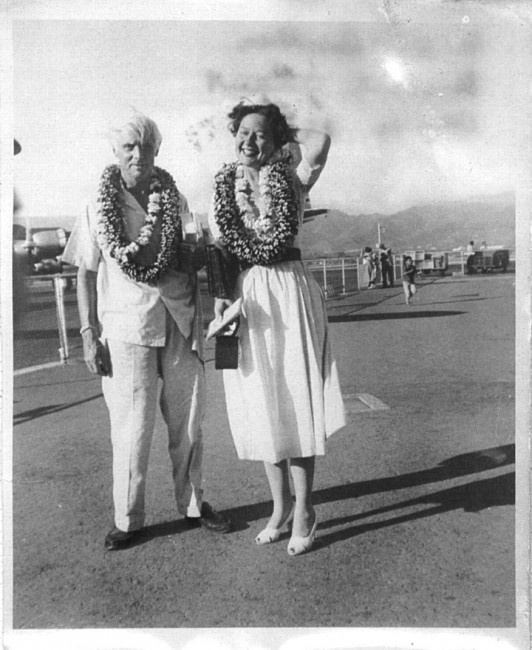Dorothea Tanning and Max Ernst, Honolulu, 1952

“In Hawaii, … (1952), we were invited by the art-critic-Iess University of Hawaii, there to lecture on art (Max) and to teach a class in painting and drawing (me). Teach! Me, teach! To say that I was not cut out for teaching would be a nice way of saying that my six-week tenure at the University of Hawaii was a total disaster. My students were mainly fun-loving dropouts from the mainland who had heard about how they could chalk up an easy credit or two while taking care of their suntans and other needs on the beaches of Honolulu. Besides, not having studied painting in a school (those three weeks back in Chicago with the charcoal?), how could I know what they say there? I couldn’t tell them about my hand, its secret pact with my brain and how it had found ways to paint the visions it found in there. I simply could not convey this procedure to a roomful of students waiting to be instructed in techniques. I wanted to say: “Go to a good museum of art and look carefully and with emotion at the pictures. Then go home and do the same thing as you have just seen. You now have craft. The rest is up to you.” But something told me this kind of talk might not go down. So, after lurching through most of the sessions with these gifted but mostly absent students and just as the last day drew near (they all miraculously showed up), I had an idea for our end-of-term exhibit: I would try a new take on the cadavre exquis.
“Here I will ask the reader to picture a roomful of students seated in a circle around a nude model on a central stand. Starting at the top of her head, everyone draws her first four inches, then folds the paper and passes it to his or her neighbor, who draws the next four. By the time the drawing is complete, it has made the full circle; thus, sixteen drawings have made the tour of the sixteen students. (Try this. Just divide the height of the object by the number of persons who must be in a circle around it.) Needless to say, the results were outrageous. Even Picasso at his most defiant could seem mild by comparison. But the cadavre exquis was not a form of expression much appreciated by the officers of the University of Hawaii when they paid us their stately end-of-term visit. In fact, they walked by our exhibit with averted eyes. And I had thought the experiment so successful! But never mind. I basked in the gentle island lifestyle and even peered into erupting Kilauea before heading back to Sedona and our homemade house, its thirsty plants, its welcoming pooches.”
—Dorothea Tanning, from Between Lives: An Artist and Her World (New York: W.W. Norton & Company, 2001), 213–14 (source).